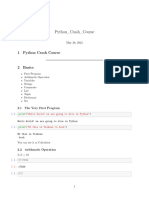0% found this document useful (0 votes)
19 views17 pagesThis Is CS50: CS50's Introduction To Computer Science
CS50's Introduction to Computer Science covers essential topics in programming and databases, focusing on Python and SQL. The lecture discusses flat-file databases, relational databases, and CRUD operations, demonstrating how to manipulate data using SQL commands. Additionally, it highlights practical coding examples for reading and processing CSV files, as well as managing data in SQL databases.
Uploaded by
shsocial1Copyright
© © All Rights Reserved
We take content rights seriously. If you suspect this is your content, claim it here.
Available Formats
Download as PDF, TXT or read online on Scribd
0% found this document useful (0 votes)
19 views17 pagesThis Is CS50: CS50's Introduction To Computer Science
CS50's Introduction to Computer Science covers essential topics in programming and databases, focusing on Python and SQL. The lecture discusses flat-file databases, relational databases, and CRUD operations, demonstrating how to manipulate data using SQL commands. Additionally, it highlights practical coding examples for reading and processing CSV files, as well as managing data in SQL databases.
Uploaded by
shsocial1Copyright
© © All Rights Reserved
We take content rights seriously. If you suspect this is your content, claim it here.
Available Formats
Download as PDF, TXT or read online on Scribd
/ 17




















































































